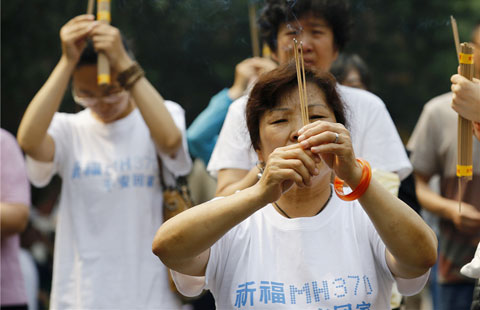Another one on the way
By Joseph Catanzaro and Yan Yiqi in Zhoushan, Zhejiang province, and Li Aoxue in Beijing ( China Daily ) Updated: 2014-02-17 09:47:25
For China's manufacturing- and export-based economy, these combined factors present a serious threat to future prosperity. Unlike many other nations around the world that are also grappling with declining births and aging, China is getting old before reaching its prime.
Professor Kerry Brown, executive director of Sydney University's China Studies Center, is unequivocal in his assessment of the problem: "The scale of it is extraordinary, and the speed of it. It's kind of like a meteor striking the planet."
Brown said the erosion of China's working-age demographic will create a labor-supply problem that will have "an inflationary impact on Chinese, and therefore global, wage levels".
Welcome news
A world away from discussions of demographics, Le and Zhou received some welcome news on Nov 19. In a major policy shift, the Third Plenary session of the 18th Communist Party of China Central Committee announced that an estimated 20 million couples would be eligible to have a second child, provided at least one parent was an only child. After the announcement, Le and Zhou's relatively sleepy island home of Zhoushan became the first region in China to move forward.
But for the couple, global speculation about whether the new policy would effectively address China's demographic woes had been superseded by a more personal matter: Zhou's accidental second pregnancy.
Before November, that would have been a problem. Now, instead of facing a crippling fine for breaching family planning rules, Zhou is happily six months along. Her unintentional head start puts her among a very small group of pregnant women whose newborns will be the first nationwide to be delivered under the new policy.
"I feel really lucky," Zhou said. "There are people I know who want a second child who don't qualify."
Located just off the coast of Zhejiang province, Zhoushan is the largest island metropolis in a sprawling archipelago. With a population of around 970,000 people spread primarily across 12 of the more than 1,000 islands in the chain, it's considered sparsely populated by Chinese standards. It is a popular holiday destination, a lively trading port and a marine industry hub.
It's also a demographic time bomb.
For 11 consecutive years, Zhoushan has recorded negative population growth. By the end of last year, people aged 60 years or older made up 20.32 percent of the population. Current projections show that by 2030, if the problem is left unchecked, a staggering 40 percent of the local population will be 60 years or older. And if that comes to pass, the number of retirees in Zhoushan will rank 16 percentage points higher than the already alarming projected national average of 24 percent.
In short, if China is beginning to brace for a gray tidal wave, Zhoushan is in line to take the brunt of it.
Weather vaneAs a microcosm of the demographic problem facing modern China, Zhoushan serves as a national weather vane indicating how Chinese are responding to the new policy. So far, Le and Zhou's enthusiasm has been slow to catch on.
In the month following the policy shift, some 3,000 locals approached Zhoushan's Municipal Health Bureau to inquire about having a second child. But that apparent interest has yet to translate into many couples who actually apply for the second child, the department's deputy director, Yang Ya'er, said.
|
|
|
|
|
|
|
|


















 Op Rana
Op Rana Berlin Fang
Berlin Fang Zhu Yuan
Zhu Yuan Huang Xiangyang
Huang Xiangyang Chen Weihua
Chen Weihua Liu Shinan
Liu Shinan